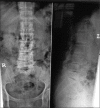Outcomes of Minimally Invasive Surgery Compared to Open Posterior Lumbar Instrumentation and Fusion
- PMID: 29114274
- PMCID: PMC5652086
- DOI: 10.4103/ajns.AJNS_331_16
Outcomes of Minimally Invasive Surgery Compared to Open Posterior Lumbar Instrumentation and Fusion
Abstract
Introduction: Degenerative spine disease is increasingly common. There are many spinal fusion techniques used to treat degenerative spine disease. This study aims to compare the functional outcome of open versus minimally invasive surgery (MIS) technique in posterior lumbar instrumentation and fusion in degenerative spine disease and to evaluate the perioperative outcome and complications between MIS and open surgery.
Materials and methods: This is an observational cross-sectional study conducted on all degenerative spine disease patients who underwent both methods of posterior lumbar instrumentation and fusion from 2010 to 2014 by the Orthopedic and Neurosurgery Department, Sarawak General Hospital. The analyzed variables were method of surgery and the levels involved, demographic data, estimated blood loss, duration of operation, length of hospitalization, visual analog scale of back pain and radicular pain preoperative, postoperative 1 month, 3 months, 6 months, 1 year, and functional outcome.
Results: One hundred and twenty-two patients underwent posterior lumbar instrumentation and fusion from 2010 to 2014. Seventy patients were subjected to MIS transforaminal lumbar interbody fusion (TLIF) and 52 open TLIF. Total 89 patients underwent single level of lumbar fusion with sixty patients in MIS group and 29 in open surgeries. MIS TLIF has less estimated blood loss and shorter hospitalization and longer operation time compared to open TLIF, which were statistically significance. MIS TLIF has statistically significance better functional outcome based on Oswestry disability index, Modified NASS score, and RAND 36-item Health Survey 1.0 score. Complications such as infection, new onsets of neurological, and dural tear are equal in both methods of surgery.
Conclusion: This study concluded that MIS has better functional outcome compared to open TLIF with shorter hospitalization, faster return to work, and less estimated blood loss.
Keywords: Minimally invasive surgery posterior lumbar instrumentation and fusion; Modified North American Spine Society Low Back Pain Outcome Instrument; Oswestry disability index; RAND-36 Item Health Survey 1.0; open posterior lumbar instrumentation and fusion; visual analog scale.
Conflict of interest statement
There are no conflicts of interest.
Figures



References
-
- Magerl FP. Stabilization of the lower thoracic and lumbar spine with external skeletal fixation. Clin Orthopod Relat Res. 1984;89:125–49. - PubMed
-
- Mathews HH, Long BH. Endoscopy assisted percutaneous anterior interbody fusion with subcutaneous suprafascial internal fixation: Evolution of technique and surgical considerations. Orthop Int Ed. 1995;3:496–500.
-
- King D. Internal fixation for lumbosacral fusion. Am J Surg. 1994;66:357–61. - PubMed
-
- Boucher HH. A method of spinal fusion. J Bone Joint Surg Br. 1959;41-B:248–59. - PubMed
LinkOut - more resources
Full Text Sources
Other Literature Sources

